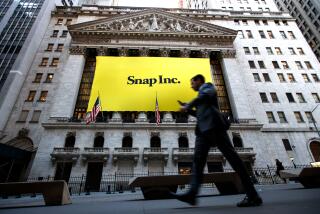Video Site to Add to Ads
- Share via
After attracting millions of eyeballs with video clips of dancing cats and lip-syncing coeds, YouTube hopes to cash in on its popularity with online infomercials.
Starting today, the video-sharing site plans to let advertisers create “channels” filled with clips they produce themselves -- and then in turn sell sponsorships to other advertisers.
Among the first: a channel created by Warner Bros. Records devoted to Paris Hilton’s new album, including the making of the music video for the song “Stars Are Blind.” Fox Broadcasting Co. will advertise on the Paris Hilton Channel to promote the fall season of the television show “Prison Break.”
Placing ads within ads further blurs the traditional lines between entertainment and its sponsors, a trend the Web is accelerating.
It also defies the conventional wisdom that the young viewers who while away afternoons on sites like YouTube and MySpace don’t want to be the targets of corporate marketing campaigns. Advertiser-produced clips frequently rank among YouTube’s most popular, particularly those with exclusive tidbits about popular shows or bands.
“These days, consumers are like walking TiVos, filtering out so much of what they see and hear in advertising,” said Mark Kingdon, chief executive of digital ad agency Organic Inc., which produced the “Prison Break” spots. “To reach this media-savvy demographic, advertisers have to ‘give to get.’ In other words, they have to give viewers something special, something unique, in exchange for their attention.”
Despite YouTube Inc.’s status as an emblem of online media, it’s never been easy for the San Mateo, Calif., company to claim much of the $17-billion online advertising market. Advertisers are reluctant to have their messages spliced together with clips that might be tasteless or violate copyrights.
YouTube attracts about 20 million viewers a month with a hypnotic mash of amateur video and snippets of big-budget movies and television shows -- many of them copied without permission. Giving advertisers their own domains with YouTube solves that problem.
“This is a way for advertisers and brands to participate in our community, to allow them more ability to customize the look and feel for the channel, to build an audience through subscription and allow user interaction with the content they created,” said Chad Hurley, CEO and co-founder of privately held YouTube, which started in 2005 as a way for friends to share home videos.
Allen Weiner, an analyst with Gartner Inc., said the ad initiative might provide YouTube revenue, but it failed to address the challenge shared by most sites that traffic in so-called viral video: how to make money on the most popular and polished amateur video it receives.
“This gets them money in the short term,” Weiner said. “It doesn’t solve the bigger issue, which is monetizing consumer-created content. They’re not doing that. And they’re in the same boat as everybody else. It’s trying to come up with mechanisms that can put the content into various buckets so that the good stuff can be parsed out and monetized.”
Another advertising initiative called Participatory Video Ad lets viewers treat advertising like any other video on YouTube -- rating it, sharing it, embedding it or commenting on it. The first such ad was for “Pulse,” a horror film distributed by Weinstein Co.’s Dimension Films.
Ad agency Deep Focus has placed movie trailers on YouTube and had released the first eight minutes of one film, “Lucky Number Slevin.”
But Deep Focus CEO Ian Schafer thought there had to be another way to tap into YouTube’s audience.
So he struck a deal to advertise on YouTube’s home page. For five days around the Aug. 11 release of “Pulse,” Deep Focus offered the film trailer and exclusive clips from the movie.
Schafer said the approach was far more effective than simply running a 15-second commercial before a video clip.
“Audiences opted in to watch the trailer, they opted in to comment on the trailer and they shared the trailer with their friends,” he said.
“For advertisers that are looking to promote their content, this is an extremely effective way to get the word out.”
Julie Supan, YouTube’s senior marketing director, said viewers didn’t seem to mind the intrusion of commercials into a community that thrives on quirky, funny original videos. The film trailer was viewed more than 1 million times.
“It just speaks of ads online these days as the best way to engage people through these viral campaigns,” Supan said.
“Great ads are in essence great content. We’re kind of blurring the lines.”
Supan said YouTube unveiled its new ad program in meetings last week with major ad agencies and ad buyers in New York.
“The advertisers recognize that when the Internet was created, they needed to find a new way to advertise online. That’s why banner ads were created,” she said. “Now they’ve recognized this is a whole new environment.”
More to Read
The biggest entertainment stories
Get our big stories about Hollywood, film, television, music, arts, culture and more right in your inbox as soon as they publish.
You may occasionally receive promotional content from the Los Angeles Times.










